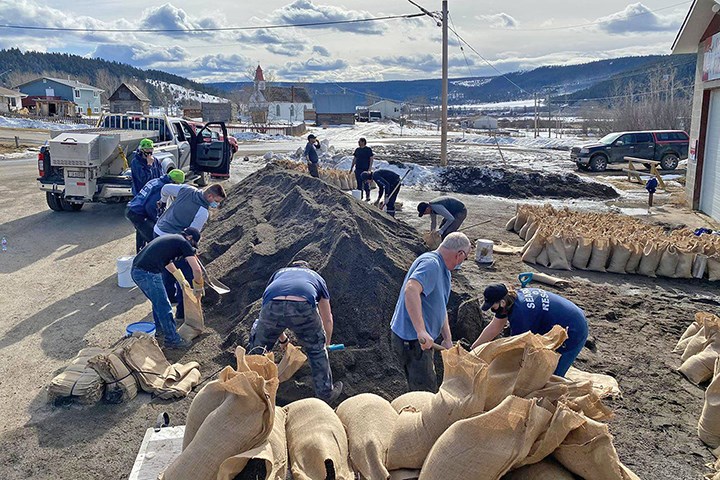More than 1,100 sandbags were assembled this past weekend as the Williams Lake First Nation (WLFN) responded to early flooding.
Lending a helping hand to public works staff in the WLFN community of Sugar Cane were eight members of Central Cariboo Search and Rescue.
The Cariboo Regional District Emergency Operations Centre provided the sandbags for the weekend work with the sand delivered by Lake Excavating.
WLFN has activated its Emergency Operations Centre (EOC) to level one.
“This year we want to make sure we’re prepared,” Chief Willie Sellars said. “With spring freshet coming soon, hopefully, we’re going to be able to keep the community safe.”
Rising water levels not seen in decades resulted in WLFN experiencing several losses last year. A section of Mission Road was destroyed due to floodwaters overwhelming Borland Creek resulting in a water line to WLFN’s water treatment plant as well as a natural gas line being compromised.
EOC director and WLFN chief administrative officer, Aaron Mannella said Asahal Creek had also impacted two residences and some flooding events occurred at their new residential development Coyote Rock Estates.
“Since then, we have spent over one million dollars in flood mitigation or response projects,” he said.
“We have about another million dollars of projects planned or designed in response to some of the events from last year, so it’s obviously imperative that we monitor the locations across the territory to mitigate more losses.”
In April 2020, the WLFN issued a pollution abatement order to the City of Williams Lake, which declared a state of emergency due to flooding and erosion in the River Valley that compromised the city’s sewage treatment system and several bridges.
Mannella said engineer designs are in place to complement the work completed by the city in the River Valley specifically on WLFN’s IR No. 4 Tillion Reserve which is located at the confluence of the Williams Creek and Fraser River.
WLFN anticipates undertaking further research and improvements around fish habitat within the River Valley in collaboration with the city after being approved to receive funding from the Trans Mountain Expansion (TMX) project.
“Because of soil stability that’s been impacted by the 2017 wildfires, the water has no place to go but down, so we’re seeing tremendous runoff heading towards the community of Sugar Cane,” Mannella said.
“Ultimately, it ends up in the lake or the hayfields around Sugar Cane, but right now, we’re working with various agencies to try and find ways to reroute that water in a way that is engineered and designed appropriately.”
The Cariboo Regional District notes it is the responsibility of homeowners to protect their property in the event of flooding.


.png;w=120;h=80;mode=crop)
.png;w=120;h=80;mode=crop)